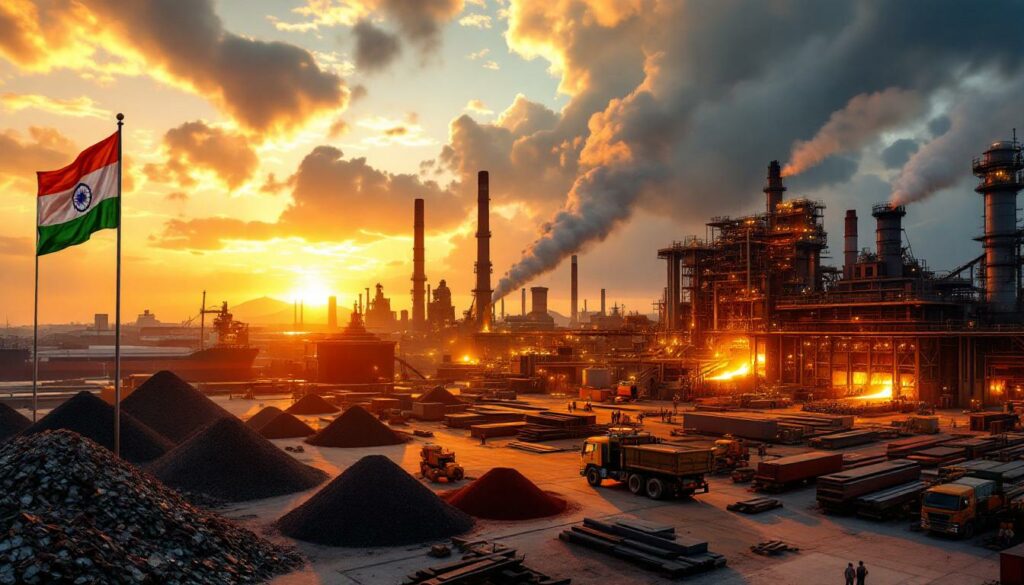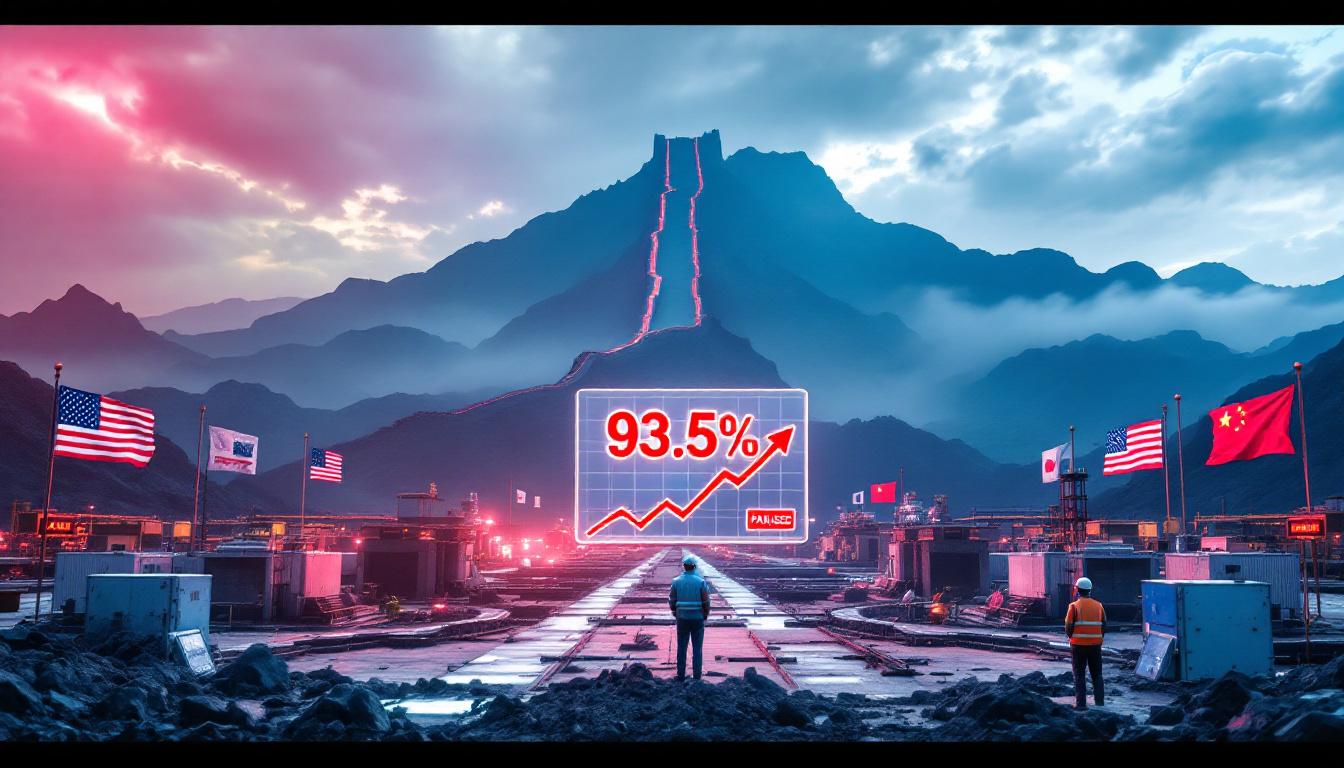How Is India's Ferrous Scrap Import Market Evolving in 2025?
India's steel sector continues to display remarkable growth in 2025, yet its ferrous scrap import dynamics reveal a complex landscape shaped by domestic alternatives, international supply challenges, and changing regulatory environments. Despite early-year recovery, India's ferrous scrap imports face persistent headwinds from competitively priced domestic alternatives and shifting global trade patterns.
The evolving relationship between domestic and imported metallics, coupled with India's ambitious steel production growth targets, creates a multifaceted market environment that demands close attention from stakeholders across the steel value chain. This complexity highlights the delicate balance between cost considerations, quality requirements, and supply security that Indian steelmakers must navigate as they adapt to changing iron ore trends.
What Factors Are Driving India's Ferrous Scrap Import Trends in 2025?
Current Import Recovery and Challenges
India's ferrous scrap imports have shown signs of recovery in early 2025, reaching 3.48 million tonnes during January-April, representing a 7.9% year-on-year increase. This uptick follows a substantial 20.2% decline in 2024, when imports fell to 9.39 million tonnes despite growing steel production.
However, this recovery remains fragile as competitive domestic alternatives continue to exert pressure on import volumes. The price advantage of local metallics, particularly direct-reduced iron (DRI), has created significant economic incentives for steelmakers to reduce their reliance on imported materials.
As one steel mill source explained: "Monsoon rains have started across India, and finished steel demand and prices are expected to stay subdued. Most mills will now rely heavily on DRI, local scrap, and pig iron rather than imported scrap."
Competitive Pressure from Domestic DRI
The most significant challenge to scrap imports comes from domestic DRI, also known as sponge iron. Local DRI prices in Gujarat were reported at ₹24,500-25,000 ($285-291) per tonne in mid-July 2025, creating a substantial price advantage over imported scrap.
This price differential has widened in recent months, making DRI increasingly attractive for steelmakers focused on optimizing input costs. The competitive pressure from domestic DRI is particularly pronounced during periods of weak finished steel demand, as mills prioritize cost control over other considerations.
The substitution effect is most evident in induction furnace operations, where DRI can replace 60-80% of the metallic charge when price differentials exceed $70 per tonne. This flexibility allows producers to adjust their raw material mix rapidly in response to changing market conditions and iron ore price forecast.
Seasonal and Market Factors
Seasonal factors play a crucial role in India's ferrous scrap import dynamics. The monsoon season (June-September) traditionally dampens construction activity and overall steel demand across the country. During this period, steelmakers typically become more cost-conscious as finished steel prices come under pressure.
Market participants note that existing port stockpiles and on-arrival cargoes are currently meeting immediate scrap needs at competitive prices. This inventory overhang further reduces the urgency for new import bookings.
Additionally, the ceasefire between Iran and Israel has restarted Middle Eastern metallics flows into India. As one trader observed: "Renewed supply is expected to put pressure on local DRI prices in the coming weeks and could affect future deep-sea scrap bookings." This geopolitical development has added another layer of complexity to India's ferrous scrap import market.
How Does the Price Relationship Between Scrap and Alternative Metallics Impact Import Decisions?
Comparative Economics of Raw Materials
The economic relationship between imported scrap and alternative metallics is the primary driver of purchasing decisions for Indian steelmakers. In June 2025, the average price for imported shredded scrap stood at $359.77 per tonne CFR Nhava Sheva, while domestic DRI averaged ₹24,650 ($288) per tonne during the same period.
This created a scrap premium of $72.10 per tonne over DRI in June 2025, higher than the 2025 year-to-date average of $63.05 but below the 2024 average of $79.74. This premium represents the additional cost steelmakers must bear to use imported scrap instead of domestic DRI.
For cost-sensitive producers, particularly those operating induction furnaces, this premium often exceeds the technical benefits of using higher-quality imported scrap. The result is a continuous optimization process where mills adjust their raw material mix based on real-time price differentials.
Historical Price Relationship Trends
The relationship between scrap and DRI prices has undergone significant changes over the past decade. Analysis of historical data reveals that the scrap-to-DRI premium has expanded considerably:
- 2015-2019: Average premium of $37.54 per tonne
- 2020-2025 to date: Average premium of $69.33 per tonne
This widening spread has fundamentally altered steelmakers' raw material sourcing strategies. The nearly doubling of the average premium has pushed many producers to maximize their use of domestic metallics whenever technically feasible.
Several factors have contributed to this expanding premium, including global scrap supply constraints, rising freight costs, and growing international competition for quality ferrous scrap. Meanwhile, India's expanding DRI production capacity has helped maintain competitive domestic prices.
Competitive Alternative Materials
Beyond domestic DRI, Indian steelmakers have access to various alternative metallics that compete with imported scrap:
- Middle Eastern hot briquetted iron (HBI) was offered at $275 per tonne CFR Kandla in July 2025
- Iron ore pellets (65% Fe) were available at $112-118 per tonne CFR Kandla
- Pig iron provides another alternative for certain applications
These alternatives create a complex decision matrix for procurement managers, who must balance cost considerations against technical requirements and logistical factors. The availability of multiple options enhances steelmakers' negotiating leverage with scrap suppliers.
For blast furnace operators, lower-priced iron ore pellets remain particularly attractive, while electric arc furnace and induction furnace mills have greater flexibility to switch between scrap, DRI, and HBI based on prevailing price relationships.
Why Isn't India's Steel Production Growth Translating to Higher Scrap Imports?
Steel Production vs. Scrap Import Disconnect
India's crude steel production rose 6.3% to 149.6 million tonnes in 2024, continuing its position as the world's second-largest steel producer. During January-May 2025, steel output reached 67.2 million tonnes, up 8.2% year-on-year, according to World Steel Association data cited by Fastmarkets.
Despite this robust production growth, scrap imports have not kept pace. This disconnect highlights the substitution effect taking place across India's steel sector, where growing domestic metallics production is increasingly meeting the raw material needs of expanding steel capacity.
The divergence between steel output growth and scrap import trends represents a structural shift in India's metallics supply chain rather than a temporary anomaly. As domestic alternatives become more available and economically competitive, the traditional correlation between steel production and scrap imports has weakened.
Domestic DRI Production Growth
A key factor explaining the disconnect is India's expanding DRI production. During January-May 2025, India produced 24.4 million tonnes of DRI, representing an 8.8% year-on-year increase. Notably, this growth rate exceeds even the robust steel production growth during the same period.
India remains the world's largest DRI producer, with abundant iron ore reserves and competitive natural gas prices in certain regions supporting this leadership position. The country's DRI production infrastructure continues to expand, with several new projects commissioned in early 2025.
This expanding domestic metallics supply reduces reliance on imported scrap, particularly for induction furnace mills that can operate efficiently with a high proportion of DRI in their metallic charge. As domestic DRI availability grows, the technical and economic incentives to import scrap diminish for many producers, further highlighting the importance of mining demand insights.
Steel Mill Sourcing Strategies
Indian steelmakers have developed sophisticated raw material sourcing strategies that prioritize cost optimization while maintaining technical performance. Induction furnace mills, which account for a significant portion of India's steel production, are increasingly favoring domestic metallics when economically viable.
Many producers are blending local scrap, DRI, and pig iron in varying proportions to optimize costs while meeting quality requirements. This flexibility in raw material usage allows mills to maintain production levels while minimizing input costs during periods of market weakness.
As one industry source noted: "India is currently receiving significant on-arrival cargoes, and stockpiles at ports are meeting demand at lower prices." This inventory availability further reduces the immediate need for new import bookings, contributing to the disconnect between steel production growth and scrap import volumes.
What Are the Long-Term Prospects for India's Ferrous Scrap Imports?
Divergent Market Perspectives
The long-term outlook for India's ferrous scrap imports generates contrasting views among market participants. Some industry observers believe imported scrap demand will remain constrained as long as domestic DRI production and local scrap collection continue to grow at current rates.
Proponents of this view point to the expanding domestic supply chain and the widening price differential between imported scrap and domestic alternatives. They argue that economic considerations will continue to favor local metallics for most applications, limiting import growth.
Conversely, others foresee growing import requirements, particularly as India's steel sector continues to evolve toward more sophisticated products. This perspective emphasizes the quality advantages of imported scrap for certain applications and the technical limitations of domestic alternatives.
Quality Considerations and New Capacity
A critical factor supporting the case for future import growth is the limited domestic supply of low-impurity shredded and busheling scrap. These higher-quality grades are essential for producing advanced steel products with stringent quality requirements.
Several major electric arc furnace (EAF) plants planned by leading steelmakers over the next five years could significantly drive import demand. As a major scrap exporter quoted by Fastmarkets observed: "Demand will be good for Indian imports within the next 2-3 years. If EAF steelmakers have to use scrap in their furnaces, they can't only depend on local scrap and sponge iron."
Tata Steel's planned 5-million-tonne EAF project in Odisha (scheduled for completion in 2027) represents the type of capacity addition that could boost scrap import requirements. Similarly, Jindal Steel and Power Ltd's expansion plans include EAF technology that typically requires higher-quality ferrous scrap inputs than are readily available domestically.
International Supply Chain Concerns
Potential supply constraints present another dimension to India's long-term scrap import outlook. Tightening export restrictions from major scrap-generating regions like the European Union create significant uncertainty for Indian importers.
India has applied for exemption from the EU's revamped Waste Shipments Regulation, which could limit access to European scrap. The European Commission is also considering potential export tariffs or restrictions on EU-origin ferrous scrap, driven by pressure from European steelmakers concerned about raw material security.
These regulatory developments could disrupt approximately 30% of India's current scrap supply, based on 2024 import patterns. Such disruptions would necessitate either alternative sourcing strategies or increased reliance on domestic metallics, potentially accelerating the substitution trend and possibly resulting in significant trade war impacts.
How Are Regulatory Changes Affecting Global Scrap Trade Flows to India?
EU Regulatory Developments
The European Union's evolving waste regulation framework represents perhaps the most significant external factor affecting India's scrap import prospects. India is among 24 non-OECD nations that have applied to continue receiving non-hazardous EU scrap classified as "waste" under the revised Waste Shipments Regulation.
The European Commission will decide on these applications by November 2026, creating a period of regulatory uncertainty for both exporters and importers. The outcome will have profound implications for global scrap trade flows, potentially redirecting significant volumes to different markets.
Beyond the Waste Shipments Regulation, the EU is considering broader measures to restrict ferrous scrap exports as part of its resource security and climate policy objectives. These potential restrictions align with the EU's Green Deal and circular economy initiatives but could significantly disrupt established trade patterns and require a thorough tariff impact analysis.
Supply Chain Resilience Strategies
In response to growing regulatory uncertainties, Indian importers are increasingly focused on supply chain resilience. Diversification of sourcing regions has become a strategic priority, with growing interest in Australian, UK, and Japanese scrap as potential alternatives to European material.
Some larger steelmakers are exploring long-term supply agreements with exporters in regions with more stable regulatory environments. These arrangements aim to secure reliable scrap flows even as global trade patterns evolve in response to changing regulations.
Alternative metallics are also gaining importance as a hedge against scrap supply disruptions. The ability to quickly adjust input mixes provides operational flexibility that can mitigate the impact of supply chain disruptions, whether caused by regulatory changes or other factors.
What Does This Mean for Market Participants?
Implications for Scrap Exporters
Exporters to India face an increasingly competitive landscape that demands both price discipline and quality differentiation. With domestic alternatives setting effective price ceilings for imported scrap, suppliers must carefully calibrate their offers to remain competitive.
Quality differentiation becomes increasingly important as a means to justify import premiums. Exporters who can consistently deliver low-impurity material with reliable physical characteristics may command premiums even in price-sensitive markets.
Building relationships with EAF-based producers may provide more stable demand, as these operations typically require higher-quality inputs than induction furnace mills. As India's steel sector gradually shifts toward more sophisticated technology, these relationships could become increasingly valuable.
Considerations for Indian Steelmakers
For Indian steelmakers, continued flexibility in raw material sourcing provides significant cost advantages. The ability to adjust input mixes in response to changing price relationships allows for ongoing optimization of production costs.
However, balancing immediate cost savings against long-term supply security remains crucial. Over-reliance on any single raw material source creates vulnerability to supply disruptions or price volatility. Maintaining the technical capability to use multiple input types provides important operational resilience.
Quality requirements for higher-value steel products may necessitate specific imported grades, regardless of cost considerations. As India's steel sector moves up the value chain, technical considerations may increasingly outweigh pure cost factors in raw material sourcing decisions.
Market Monitoring Priorities
Several key indicators require ongoing attention from market participants:
- The relationship between domestic DRI and imported scrap prices remains the primary driver of import volumes
- Regulatory developments in major scrap-exporting regions will impact future availability and potentially pricing
- New steel capacity additions and their technological choices will shape long-term demand patterns
- Domestic scrap collection growth rates will influence the balance between local and imported material
Sophisticated market participants are increasingly using real-time price tracking tools and market intelligence services to optimize procurement decisions. This data-driven approach allows for more responsive adjustments to changing market conditions.
FAQ: India's Ferrous Scrap Import Market
How has India's ferrous scrap import volume changed in early 2025?
India's ferrous scrap imports reached 3.48 million tonnes in January-April 2025, representing a 7.9% increase compared to the same period in 2024. This recovery follows a significant decline of 20.2% for the full year 2024, when imports fell to 9.39 million tonnes despite growing steel production.
What is causing pressure on India's scrap import demand?
The primary pressure comes from competitive domestic DRI (sponge iron) prices, which make imported scrap less economically attractive. Additional factors include seasonal demand weakness during monsoon season, inventory overhang at ports, and renewed availability of Middle Eastern metallics following the Iran-Israel ceasefire.
How does India's steel production growth compare to its scrap import trends?
While India's crude steel production grew by 8.2% year-on-year in January-May 2025, scrap imports have not kept pace. This disconnect is largely due to the substitution effect from growing domestic DRI production, which increased by 8.8% during the same period, outpacing even steel production growth.
What regulatory challenges could affect India's future scrap imports?
Potential EU export restrictions on ferrous scrap and changes to the EU's Waste Shipments Regulation could limit India's access to European scrap. India has applied for exemptions from these restrictions, with decisions expected by November 2026. These regulatory developments could disrupt approximately 30% of India's current scrap supply.
Further Exploration:
Readers interested in learning more about India's ferrous scrap market dynamics can also explore related educational content available from Fastmarkets, which offers regular market analysis and pricing information on global ferrous scrap markets.
Want to Catch the Next Major Mineral Discovery Before the Market?
Discovery Alert's proprietary Discovery IQ model delivers instant notifications when significant ASX mineral discoveries are announced, giving traders and investors a crucial edge before wider market recognition. Explore our dedicated discoveries page to see how historic mineral discoveries have generated substantial returns and start your 30-day free trial today.




